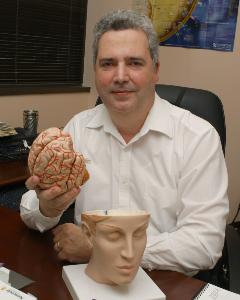Dr. Manuel F. Casanova
Manuel F. Casanova, M.D. is Gottfried and Gisela Kolb Endowed Chair in Psychiatry, Associate Chair for Research, Department of Psychiatry, The University of Louisville.
Manuel made his residency training in neurology and then spent 3 years doing a fellowship in neuropathology at The Johns Hopkins Hospital. During his stay at the Johns Hopkins Hospital, he was in charge of Pediatric Neuropathology, a fact which kindled his interest in developmental disorders of the brain. His clinical experience was enhanced by appointments as either a consultant or staff neuropathologist at Sinai Hospital (Maryland), the North Charles Hospital and the D.C. General Hospital.
He spent several years as Deputy Medical Examiner for Washington, D.C., where he gained valuable experience in the post-mortem examination of Sudden Infant Death Syndrome and child abuse. His expertise in the field was recognized by honorary appointments as a Scientific Expert for the Armed Forces Institute of Pathology and as a Professorial Lecturer for the Department of Forensic Science at George Washington University.
Manuel spent 8 years helping to establish two of the most successful brain banks in this country: The Johns Hopkins Brain Resource Center (3 years) and the Brain Bank Unit of the Clinical Brains Disorders Branch at the National Institutes of Mental Health (5 years). At present, he is well published in a multitude of postmortem techniques including neuronal morphometry immunocytochemistry, neurochemistry, and autoradiography.
He has had over twenty years of experience in the neurosciences. Although trained in the classical methods of neurology and neuropathology, his interest has gradually shifted towards the study of abnormalities of cortical circuitry. His research has focused on the cell minicolumn, a vertical conglomerate of 80 to 100 neurons having a common latency of response to stimulation.
Using computerized imaging analysis, he has established the anatomical validity of the cell minicolumn. His earlier work has reported interhemispheric differences in the morphometry of minicolumns that could provide for the speciation of hominids. Localized in Broadmann area 22 — part of Wernicke’s language region — the morphometric difference may play a role both in the development of language and in its disorders. His most recent studies have looked for the presence of abnormalities of minicolumnar organization and lateralization in the brains of patients who exhibit language disturbances, including autism, Asperger’s syndrome, and dyslexia.
Manuel edited Neocortical Modularity And The Cell Minicolumn and Recent Developments in Autism Research, and coedited Asperger’s Disorder.
His papers include Planum Temporale Asymmetry Reversal in Schizophrenia: Replication and Relationship to Gray Matter Abnormalities, Minicolumnar pathology in autism, Temporal lobe pathology in schizophrenia: a quantitative magnetic resonance imaging study, Asymmetry of the planum temporale: methodological considerations and clinical associations, Quantitative analysis of cell columns in the cerebral cortex, and Cortical Gyrification in the Rhesus Monkey: A Test of the Mechanical Folding Hypothesis.
Manuel earned his B.Sc. in Chemistry from the Universidad de Puerto Rico, Río Piedras in 1973 and his M.D. at Escuela de Medicina, Universidad de Puerto Rico, San Juan in 1979.
Listen to Autism: Alternatives in Health : Manuel Casanova, MD – Abnormalities of Cortical Circuitry in the Brains of Autistic Individuals Episode. Read Transcranial Magnetic Stimulation (TMS) May Alleviate Symptoms of Autism and U of L Researchers use Magnets in Autism Research.
